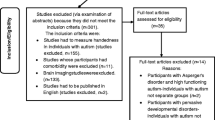Abstract
Children with autism spectrum disorder (ASD) exhibit social-communicative impairments. Less is known about the neuropsychological profile of ASD, although cognitive and neuropsychological deficits are evident. We modelled neuropsychological function in 20 children with ASD and 20 sex, age and IQ matched typically-developing controls (ages 7–14) as a network of interacting parameters. Graph theoretical analysis was applied to identify critical topographic regions within this network. Two areas were significantly stronger hubs in typically-developing children, the ability to shift attention (p < 0.001) and overall executive function (p < 0.001). Planning/organization was a stronger hub in the cognitive networks of children with ASD (p = 0.001). We show that ASD is not only characterized by impairments in various neurocognitive domains, but also alterations in their interaction.


Similar content being viewed by others
References
American Psychiatric Association. (2013). Diagnostic and statistical manual of mental disorders (5th edn.). Washington, DC: Author.
Conners, C. K. (1997). Conner’s Rating Scales–Revised:Tech-Nical Manual. Multi-Health Systems.
Constantino, J. N., & Gruber, C. P. (2005). Social Responsiveness Scale (SRS) Manual. Western Psychological Services.
Geurts, H. M., de Vries, M., & van den Bergh, S. F. (2014). Executive functioning theory and autism. In S. Goldstein & J. A. Naglieri (Eds.), Handbook of executive functioning (pp. 121–141). New York, NY: Springer.
Gilotty, L., Kenworthy, L., Sirian, L., Black, D. O., & Wagner, A. E. (2002). Adaptive skills and executive function in autism spectrum disorders. Child Neuropsychology, 8(4), 241–248.
Gioia, G. A., Isquith, P. K., Guy, S. C., & Kenworthy, L. (2000). Behaviour rating inventory of executive function (BRIEF). Assessment Measure. Psychological Assessment Resources Inc.
Hill, E. L. (2004). Evaluating the theory of executive dysfunction in autism. Developmental Review, 24(2), 189–233.
Ibrahim, G. M., & Macdonald, R. L. (2015). The network topology of aneurysmal subarachnoid haemorrhage. Journal of Neurology, Neurosurgery and Psychiatry, 86(8), 895–901.
Joseph, R. M., & Tager–Flusberg, H. (2004). The relationship of theory of mind and executive functions to symptom type and severity in children with autism. Development and Psychopathology, 16(1), 137–155.
Kellermann, T. S., Bonilha, L., Lin, J. J., & Hermann, B. P. (2015). Mapping the landscape of cognitive development in children with epilepsy. Cortex; A Journal Devoted to the Study of the Nervous System and Behavior, 66, 1–8.
Kenworthy, L., Black, D. O., Harrison, B., Della Rosa, A., & Wallace, G. L. (2009). Are executive control functions related to autism symptoms in high-functioning children? Child Neuropsychology, 15(5), 425–440.
Leung, R. C., Vogan, V. M., Powell, T. L., Anagnostou, E., & Taylor, M. J. (2016). The role of executive functions in social impairment in autism spectrum disorder. Child Neuropsychology, 22(3), 336–344.
Lopez, B. R., Lincoln, A. J., Ozonoff, S., & Lai, Z. (2005). Examining the relationship between executive functions and restricted, repetitive symptoms of autistic disorder. Journal of Autism and Developmental Disorders, 35, 445–460.
Luna, B., Doll, S. K., Hegedus, S. J., Minshew, N. J., & Sweeney, J. A. (2007). Maturation of executive function in autism. Biological Psychiatry, 61(4), 474–481.
Myers, S. M., Johnson, C. P., & American Academy of Pediatrics Council on Children With Disabilities. (2007). Management of children with autism spectrum disorders. Pediatrics, 120(5), 1162–1182.
Rubin, D. B. (1997). Estimating causal effects from large data sets using propensity scores. Annals of Internal Medicine, 127(8 Pt 2), 757–763.
Rubinov, M., & Sporns, O. (2010). Complex network measures of brain connectivity: Uses and interpretations. NeuroImage, 52(3), 1059–1069.
South, M., Ozonoff, S., & McMahon, W. M. (2007). The relationship between executive functioning, central coherence, and repetitive behaviors in the high-functioning autism spectrum. Autism: The International Journal of Research and Practice, 11, 437–451.
Sumiyoshi, C., Kawakubo, Y., Suga, M., Sumiyoshi, T., & Kasai, K. (2011). Impaired ability to organize information in individuals with autism spectrum disorders and their siblings. Neuroscience Research, 69(3), 252–257.
Turner, M. (1999). Generating novel ideas: Fluency performance in high-functioning and learning disabled individuals with autism. Journal of Child Psychology and Psychiatry and Allied Disciplines, 40, 189–201.
Wechsler, D. (2002). Wechsler Abbreviated Scales of Intelligence. Psychological Corporation.
Acknowledgments
No financial support was received for this work.
Author Contributions
George M. Ibrahim conceived the idea, performed the analysis, drafted the manuscript and approved the final version of the manuscript. Benjamin R. Morgan performed the analysis, edited the manuscript and approved the final version of the manuscript. Vanessa M. Vogan collected the data, drafted the manuscript, edited the manuscript and approved the final version of the manuscript. Rachel C. Leung collected the data, drafted the manuscript, edited the manuscript and approved the final version of the manuscript. Evdokia Anagnostou edited the manuscript and approved the final version of the manuscript. Margot J. Taylor supervised the project, edited the manuscript and approved the final version of the manuscript.
Author information
Authors and Affiliations
Corresponding author
Ethics declarations
Conflict of Interest
The authors declare they have no conflicts of interest.
Ethical Approval
All procedures performed in studies involving human participants were in accordance with the ethical standards of the institutional and/or national research committee and with the 1964 Helsinki declaration and its later amendments or comparable ethical standards.
Informed Consent
Informed consent was obtained from all individual participants included in the study.
Rights and permissions
About this article
Cite this article
Ibrahim, G.M., Morgan, B.R., Vogan, V.M. et al. Mapping the Network of Neuropsychological Impairment in Children with Autism Spectrum Disorder: A Graph Theoretical Analysis. J Autism Dev Disord 46, 3770–3777 (2016). https://doi.org/10.1007/s10803-016-2929-8
Published:
Issue Date:
DOI: https://doi.org/10.1007/s10803-016-2929-8




